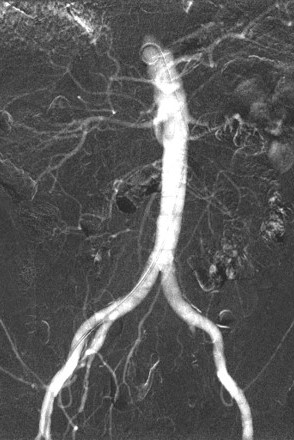Carbon dioxide angiography
Medical imaging technique using carbon dioxide as a contrast agent
Carbon dioxide angiography is a medical imaging technique that utilizes carbon dioxide (CO2) as a contrast agent to visualize blood vessels. This method is particularly useful in patients who are at risk of allergic reactions to iodinated contrast media or have renal insufficiency.
History[edit | edit source]
The use of carbon dioxide as a contrast agent in angiography dates back to the early 20th century. However, it was not until the 1970s that CO2 angiography gained wider acceptance, thanks to advancements in imaging technology and a better understanding of its safety profile. The technique was pioneered by Dr. Hawkins, who demonstrated its efficacy and safety in various vascular procedures.
Mechanism[edit | edit source]
Carbon dioxide is a colorless, odorless gas that is naturally present in the body. When injected into the bloodstream, it displaces blood and creates a negative contrast effect, allowing for the visualization of blood vessels. CO2 is highly soluble in blood and is rapidly eliminated through the lungs, minimizing the risk of adverse reactions.
Applications[edit | edit source]
CO2 angiography is primarily used in patients with chronic kidney disease or those who have had previous allergic reactions to iodinated contrast agents. It is commonly employed in:
- Peripheral artery disease
- Renal artery stenosis
- Aortic aneurysm repair
- Transjugular intrahepatic portosystemic shunt (TIPS) procedures
Advantages[edit | edit source]
- Safety: CO2 is non-allergenic and does not cause nephrotoxicity, making it safer for patients with kidney issues.
- Cost-effectiveness: CO2 is inexpensive compared to iodinated contrast agents.
- Rapid clearance: The gas is quickly absorbed and expelled by the body, reducing the risk of complications.
Limitations[edit | edit source]
Despite its advantages, CO2 angiography has some limitations:
- Imaging quality: The image quality may be inferior to that of iodinated contrast agents, particularly in larger vessels.
- Gas embolism: There is a risk of gas embolism if CO2 is injected incorrectly, although this is rare with proper technique.
- Limited use in cerebral circulation: CO2 is not used in cerebral angiography due to the risk of neurotoxicity.
Procedure[edit | edit source]
The procedure for CO2 angiography involves the following steps:
1. Patient preparation: The patient is positioned, and the area of interest is sterilized. 2. Catheter insertion: A catheter is inserted into the vascular system, usually through the femoral artery. 3. CO2 injection: Carbon dioxide is injected through the catheter using a specialized delivery system. 4. Imaging: Real-time imaging is performed to visualize the blood vessels.
Safety Considerations[edit | edit source]
While CO2 angiography is generally safe, certain precautions must be taken:
- Proper technique: Ensuring correct injection technique to prevent gas embolism.
- Monitoring: Continuous monitoring of the patient’s vital signs during the procedure.
- Patient selection: Careful selection of patients to avoid those with contraindications.
Related pages[edit | edit source]
Search WikiMD
Ad.Tired of being Overweight? Try W8MD's physician weight loss program.
Semaglutide (Ozempic / Wegovy and Tirzepatide (Mounjaro / Zepbound) available.
Advertise on WikiMD
|
WikiMD's Wellness Encyclopedia |
| Let Food Be Thy Medicine Medicine Thy Food - Hippocrates |
Translate this page: - East Asian
中文,
日本,
한국어,
South Asian
हिन्दी,
தமிழ்,
తెలుగు,
Urdu,
ಕನ್ನಡ,
Southeast Asian
Indonesian,
Vietnamese,
Thai,
မြန်မာဘာသာ,
বাংলা
European
español,
Deutsch,
français,
Greek,
português do Brasil,
polski,
română,
русский,
Nederlands,
norsk,
svenska,
suomi,
Italian
Middle Eastern & African
عربى,
Turkish,
Persian,
Hebrew,
Afrikaans,
isiZulu,
Kiswahili,
Other
Bulgarian,
Hungarian,
Czech,
Swedish,
മലയാളം,
मराठी,
ਪੰਜਾਬੀ,
ગુજરાતી,
Portuguese,
Ukrainian
Medical Disclaimer: WikiMD is not a substitute for professional medical advice. The information on WikiMD is provided as an information resource only, may be incorrect, outdated or misleading, and is not to be used or relied on for any diagnostic or treatment purposes. Please consult your health care provider before making any healthcare decisions or for guidance about a specific medical condition. WikiMD expressly disclaims responsibility, and shall have no liability, for any damages, loss, injury, or liability whatsoever suffered as a result of your reliance on the information contained in this site. By visiting this site you agree to the foregoing terms and conditions, which may from time to time be changed or supplemented by WikiMD. If you do not agree to the foregoing terms and conditions, you should not enter or use this site. See full disclaimer.
Credits:Most images are courtesy of Wikimedia commons, and templates, categories Wikipedia, licensed under CC BY SA or similar.
Contributors: Prab R. Tumpati, MD

